1. 引言
随着工业的发展,生产过程中产生的挥发性有机物和恶臭气体不仅对人类健康造成危害,也对环境造成了污染,越来越引起人们的关注[1]。目前,处理恶臭气体的常用技术主要有物理吸附、光催化、化学吸收、燃烧法、生物法[2]等。其中吸附法应用极为广泛,具有去除效率高、净化彻底、能耗低、工艺成熟等优点,具有很好的环境和经济效益,吸附剂要求具有高密度的细孔结构,比表面积大,化学性质稳定,耐酸碱、耐水、耐高温高压,不易压碎,对空气阻力小等特点[2],常用的有活性炭、活性氧化铝、硅胶、人工沸石等[3]。
固相微萃取技术(SPME)通常与气相色谱或气质联用,适于分析环境、食品、生物材料中的挥发性及半挥发性成分分析,在环境监测过程中也发挥着巨大的作用[4-6]。
玉米芯是一种产量巨大、来源广泛的农业副产物,本身具有良好的稳定性,并且具有较好的机械强度。玉米芯主要由纤维素和木质素组成,据测定,新鲜玉米芯含粗蛋白2%~6%,粗脂肪0.5%,可溶性无氮物52.9%,粗纤维33.1%,灰分3.2%,水分77%[7]。由于玉米芯的化学构中含有羧基、氨基、苯环等活泼性化学基团[8],使其能够发生离子交换吸附或化学吸附作用。很多学者利用玉米芯的多孔结构和吸附特性处理不同类型的重金属废水[8-10],而利用玉米芯作为填料处理废气的研究极少,因此,本研究以玉米芯为吸附填料,考察对恶臭气体的净化性能。
2. 材料与方法
2.1. 材料与仪器
pH计,梅特勒–托利多仪器(上海)有限公司;气相色谱仪GC2010,岛津公司;手动SPME进样装置美国Superlco公司;MA30水分仪,SARTORIUS公司。
实验装置(图1)主要包括气体生成系统和吸附塔。气体生成系统内部为厨余垃圾(多为高蛋白组分),不定期向气体罐内补充原料以保证恶臭气体的来源,吸附塔内径5 cm,高75 cm,填料填装70 cm,通过顶部定时补水,保持填料含水率70%左右。
填料为玉米芯,粒径10 mm × 10 mm × 12 mm,自然堆积密度0.12 g∙cm–3。
2.2. 气体成分测定
气体成分分析前,通过对出口处气体萃取优化萃取条件:
1) 萃取时间10 min,分别用100 μm PDMS、65 μm
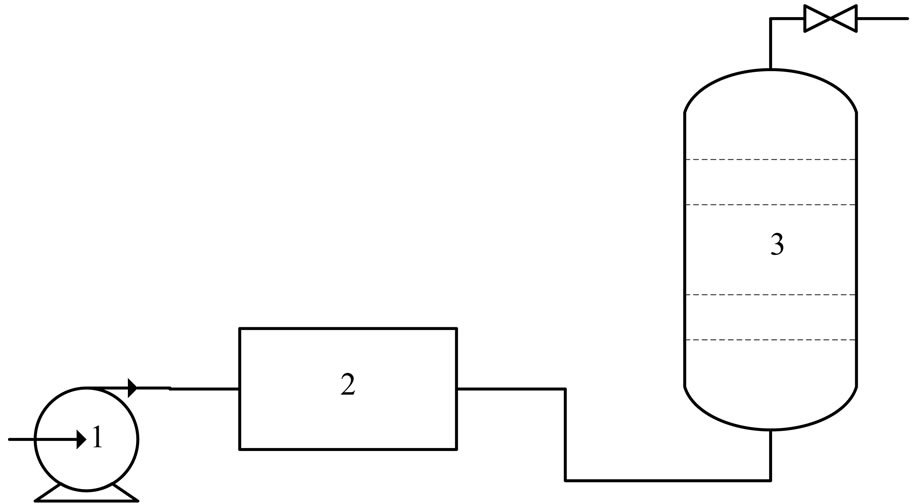
1. 空气泵;2. 气体发生室;3. 吸附塔
Figure 1. Schematic diagram of experimental apparatus
图1. 试验装置图
PDMS/DVB、75 μm CAR/PDMS三种萃取头萃取恶臭气体,根据峰面积选择适宜萃取头;2) 用选取的萃取头在3 min、5 min、10 min、15 min条件下分别萃取,根据峰面积选择适宜萃取时间。
取样间隔时间5 h~6 h,取样时将SPME取样装置至于吸附塔进气口和出气口处,吸附5 min,进行GC分析。
恶臭气体去除率计算公式如下:

其中,去除率为恶臭气体去除率;
c1为吸附塔进气口恶臭气体浓度;
c2为吸附塔出气口恶臭气体浓度。
2.3. 色谱条件
色谱柱:rtx-5毛细管柱(30 m × 0.25 mm,0.25 μm);程序升温:初温50℃、保持2 min,以40℃/min上升至130℃、保持2 min,再以40℃/min上升至150℃、保持1 min;进样口温度160℃;载气为氮气,流量2.5 mL/min;检测器:FPD,180℃。
2.4. pH及水分测定
pH:取1.0 g玉米芯于烧杯中,加入25 mL去离子水,浸泡30 min后过滤,测定滤液pH。
含水率:取3.00 g玉米芯用水分仪测定。
3. 结果与分析
3.1. 色谱条件优化
为了使色谱条件用于痕量分析,本实验比较了色谱柱流量分别为1.0 mL/min、1.5 mL/min、2.0 mL/min、2.5 mL/min的分离条件(图2),当柱流量提升后,目标物质出峰时间提前,峰型变瘦,同时,当柱流量为2.5 mL/min时,两种硫醇类物质得到很好的表征,因此,本实验选择2.5 mL/min柱流量。
确定基本实验条件后,色谱图如图3,可以看出,FPD检测器监测得到的三种硫醇物质峰,分别在2.5 min、4.2 min、6.3 min得到表征。
由于在通气过程中,三种组分的比例会发生一定变化,且变化不成规律,但主要组分均是三种硫醇物质,因此测定时,本研究采用三种物质峰面积的和进行计算,简便快捷,对非含硫物质的吸附也能起到一定的说明作用。
3.2. SPME萃取条件优化
3.2.1. 不同萃取头的选择
室温下,在通气状态下分别用100 μm PDMS、65 μm PDMS/DVB、75 μm CAR/PDMS三种萃取头在吸

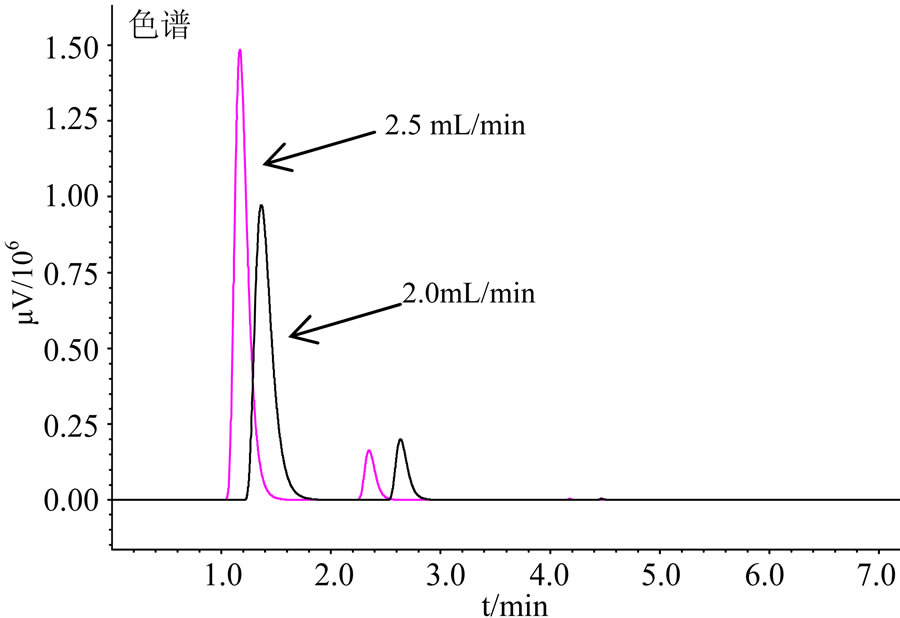
Figure 2. Chromatographic maps of different column flow
图2. 不同柱流量色谱图

Figure 3. Chromatographic map
图3. 色谱图
附塔出气口处萃取10 min,GC分析得到结果(图4)。从各图中可以看出,三种萃取头均可用于检测,其中75 μm CAR/PDMS所萃取的气体峰面积最大,65 μm PDMS/DVB次之,100 μm PDMS峰面积最小。因此本实验选择75 μm CAR/PDMS萃取头为实验所用。
3.2.2. 萃取时间的选择
选用75 μm CAR/PDMS萃取头,在不同的萃取时间3 min、5 min、10 min、15 min条件下,分别萃取吸附出气口恶臭气体,利用GC得到的总峰面积作对比分析,如图5所示,3 min峰面积最小,但可达到检测要求,5 min、10 min、15 min所得到的萃取结果差异不大。同时考虑到检测时间和痕量检测等因素,本研究选用5 min作为检测恶臭气体的最佳选择。
3.3. 填料水分含量选择
填料含水率是物理吸附过滤系统中生物活性、气液间分配及传质的主要影响因子,含水率过高会导致空隙率下降,影响污染物、氧气在水膜间的传质,而含水率过低则会降低吸附效果[11,12]。
本实验采用天然玉米芯为填料,在吸附塔内分别填装含水率为10%、30%、50%、70%的玉米芯,通气5 h后,测定出口处恶臭气体含量,以峰面积记录含量,结果如图6所示。在相同的吸附时间下,随着填料含水率的增加,出气口处恶臭气体的含量逐渐降低,含水率从10%上升到50%时,出气口恶臭气体含量下降很快,当上升到70%时,含量下降略低。本实验所用玉米芯饱和含水率在70%~80%左右,所以选用含水率70%的玉米芯作为本实验的条件。
李顺义等人研究表明,用玉米芯吸附氨气时40%~

Figure 4. Extraction results of different extraction fiber
图4. 不同萃取头吸附效果图

Figure 5. Extraction results of different time
图5. 不同萃取时间吸附效果图
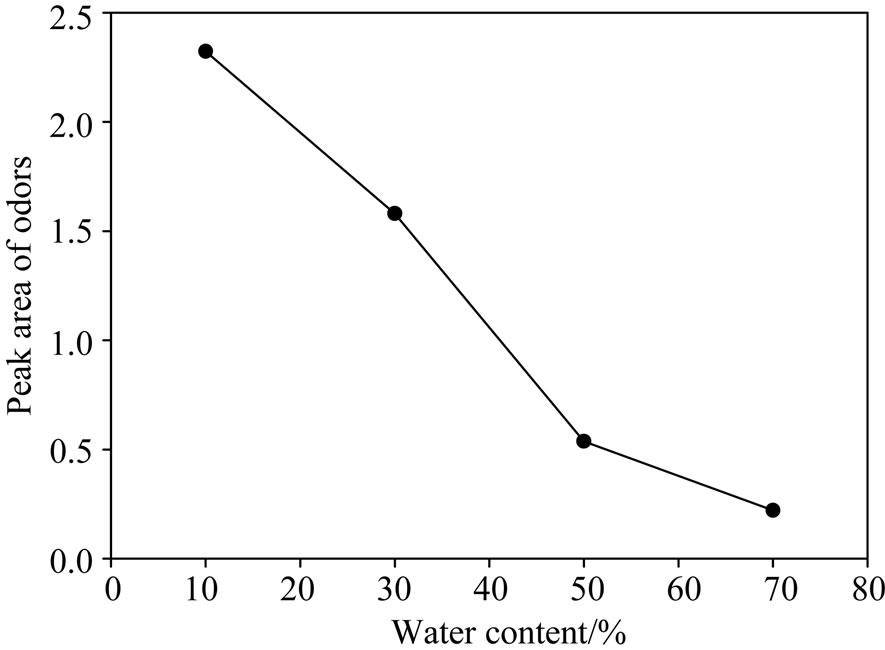
Figure 6. The effect of water content on adsorption capacity
图6. 含水率对吸附效果影响
50%左右含水率的玉米芯吸附效果最好[13],而本研究中针对的挥发性恶臭气体,含水率为70%时去除效果最好。
3.4. 填料高度的选择
填料高度直接影响着吸附塔对恶臭气体的去除效率以及实际使用的运行成本。本实验考察了不同的填料高度对除臭效果的影响(图7),通气10 h,填料高度为20 cm时,去除率仅为10.1%,随着填料高度的逐渐增加(40 cm、60 cm、70 cm、80 cm),去除率逐渐升高(60.2%、76.7%、97.4%、98.0%),说明在实验室条件下,填料高度对去除效果的影响显著,填料高度为70 cm和80 cm时去除率基本相当,所以在实验室条件下选择70 cm为实验条件。实际工程中应根据进气量及容积负荷等确定选用填料高度,不可盲目增加而造成资源浪费。
3.5. 空气流速的选择
本实验分别设计进气量为0.1 m3/h、0.2 m3/h、0.4 m3/h、0.8 m3/h,对应空床停留时间分别为49.48 s、24.74 s、12.37 s、6.19 s,对比吸附塔出口处恶臭气体浓度。气体流速为0.1 m3/h时出口浓度最低,去除率最高,随着进气流速的升高,出口恶臭气体浓度不断升高(图8),净化效率降低,实验过程中选择0.1 m3/h的进气量进行实验。进气流量决定停留时间,停留时间和进气浓度对净化效率又有重要影响,实际过程中应根据实际情况进行工程核算,选择合适的进气流量,使净化效率达到最优。
3.6. 除臭效果对比
3.6.1. 运行及间歇时间的选择
确定吸附塔条件后,需要进行连续吸附试验,由

Figure 7. The effect of packing height on removal ratio
图7. 填料高度对吸附效果影响

Figure 8. The effect of flow rate on removal efficiency
图8. 进气量对除臭效果的影响
于本研究的恶臭气体由自制发酵罐(装置2)中的厨余垃圾提供,臭气源的稳定对试验结果有着重要影响。
采用0.1 m3/h流速,并采用3.2所述条件在装置2出口处进行吸附,然后进行GC检测,连续通气12 h(图9)。可以看出,在通气的最初1 h~1.5 h内,恶臭气体浓度急剧下降,从3 h~12 h,恶臭气体浓度基本恒定,但12 h时,臭气浓度相比3 h时已下降了57%。因此可认为,当通气1 h~1.5 h后是进行试验的合适时机,可连续运行10 h左右,至12 h时已经不再适合进行连续吸附研究,需终止实验,进行密闭发酵。因此,每次实验前,测定装置2出口处的恶臭气体浓度,当浓度偏差在15%以内可认为符合试验条件,可进行试验。
3.6.2. 连续运行除臭结果对比
国内外对以玉米芯为吸附填料考察除臭效果的研究鲜见报道,本研究以前期试验得出的优化条件:粒径10 mm × 10 mm × 12 mm,自然堆积密度0.12 g∙cm–3,含水率70%,进行试验。连续运行10 h~12 h,间歇8 h~10 h,以保证恶臭气体的浓度(此过程中吸附塔密封),进行连续吸附,除臭效果如图10所示(横坐标扣除间歇时间),可以看出,连续吸附47 h前,玉米芯对恶臭气体的去除率维持在85%~95%,具有良好的除臭效果,47 h后,除臭率急剧下降,55 h已下降为47%,59 h时除臭率下降为32%,基本已经失去吸附效果,可以认为已经达到吸附饱和,这与李顺义[13]等人报道天然玉米芯吸附氨气在60 h达到饱和的
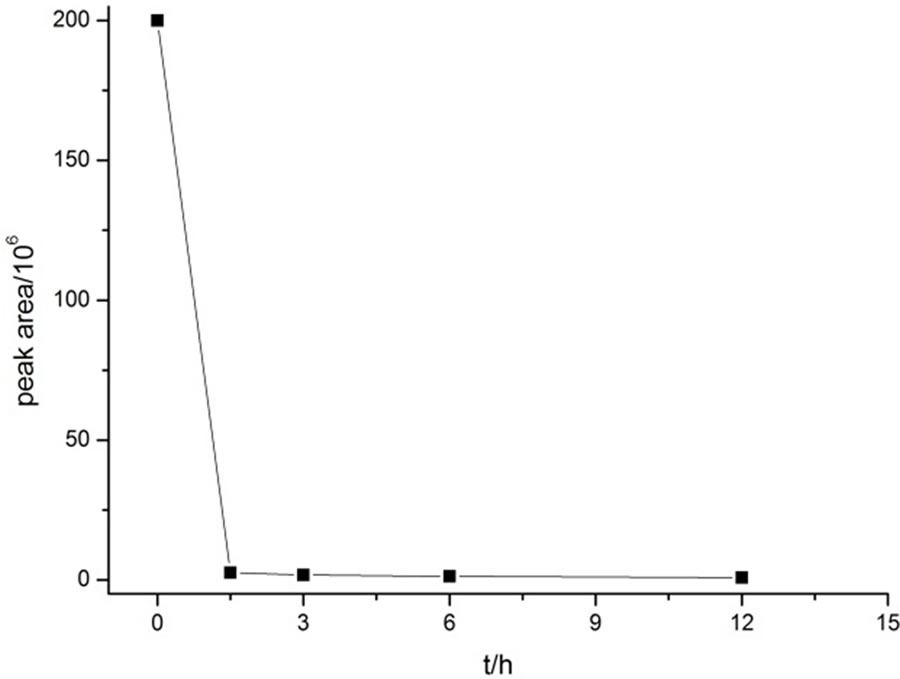
Figure 9. The change of odors
图9. 恶臭气体浓度变化
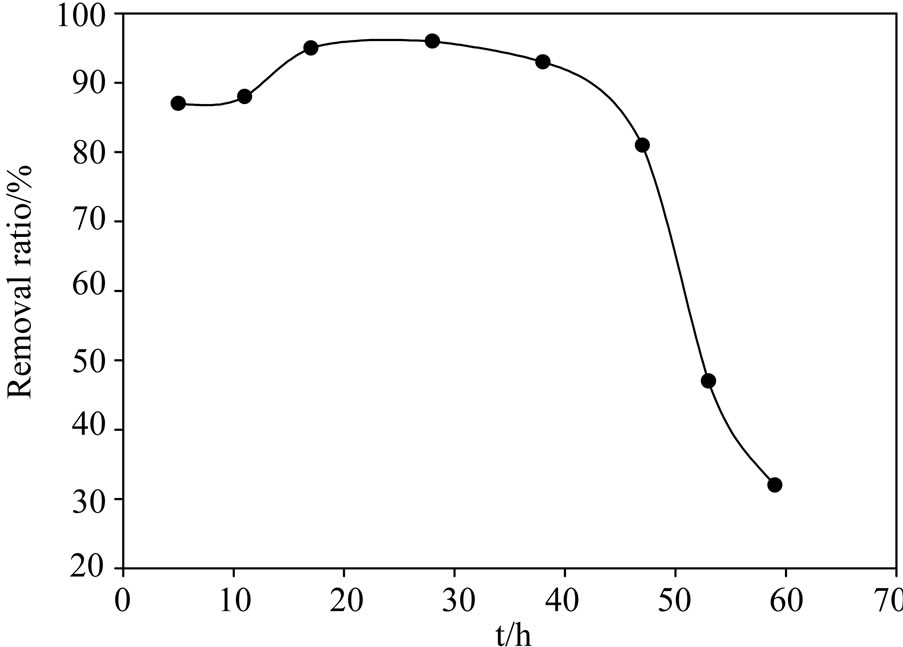
Figure 10. Purification efficient of corn-cob
图10. 玉米芯对恶臭气体吸附效果
结果基本类似,证明玉米芯本身疏松多孔的结构对臭气有一定的吸附作用。
同时,吸附过程中发现天然玉米芯有微生物生长迹象,肉眼只能辨别出霉菌,可能对除臭有一定的促进作用,有学者研究表明天然玉米芯表面的微生物对除臭有一定的作用[13],但由于玉米芯在运送、贮存过程中,由于产地不同、环境不同,菌群的差异也较大,同时如若进行灭菌处理,对玉米芯的结构又可能产生不良影响,因此难以得出较有价值的结论。
将吸附饱和的玉米芯取出,按照2.4方法分别测定其pH,结果如图11。从图中可以看出,未进行吸附时,空白玉米芯的pH在5.69,吸附饱和后,底部、中部、上部的pH分别为7.23、6.55和6.44。这说明恶臭气体中含有大量溶于水后成碱性的气体,升高了原有玉米芯的pH;中部玉米芯的pH6.55仅比上部高
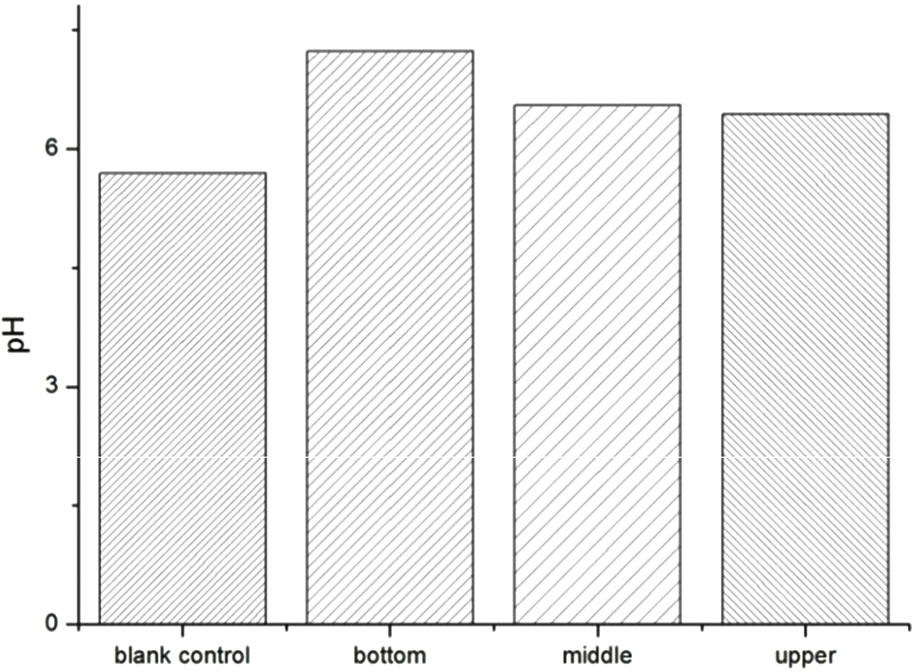
Figure 11. pH of corn-cob
图11. 玉米芯pH 0.11,却比底部低0.68,表明在吸附过程中底部填料所发挥的作用要高于中部和上部,通过进气量和工程核算,调整适宜进气量和吸附温度,有可能使玉米芯继续发挥良好的吸附作用。
4. 结论
本研究以玉米芯为填料,吸附净化恶臭气体,采用SPME-GC作为监测手段,对吸附条件、检测条件及吸附效果进行了研究。
1) 采用75 μm CAR/PDMS萃取头吸附恶臭气体5 min,可以实现恶臭气体的有效检测;
2) 气相色谱的升温程序能够有效分离三种硫醇物质,FPD检测器能够实现有效检测;
3) 玉米芯吸附恶臭气体的最优条件为含水率70%、自然堆积密度0.12 g∙cm–3、填料高度65 cm、进气流速0.1 m3∙h–1;
4) 最优条件下,吸附塔动态吸附恶臭气体47 h,对恶臭气体净化率维持在85%~95%,效果良好。
5. 致谢
本研究受国家“十一五”科技支撑计划(2009BADC2B02)支持。
NOTES
*基金项目:“十一五”国家科技支撑计划(2009BADC2B02)。
#通讯作者。